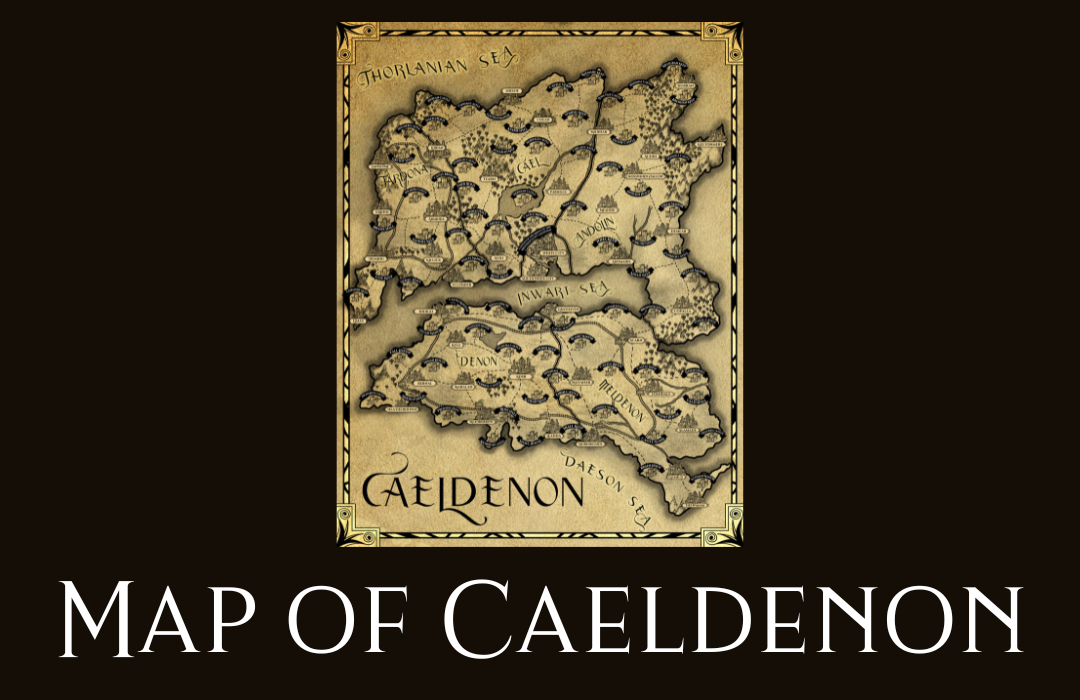Even though Lithonia is the country at the center of the In Blood and Fire Series, Caeldenon was the first Kingdom I focused on when it came to culture. The fact that Caeldenon is made up of five countries, each with their own monarchy, makes it more interesting.
My inspiration for Caeldenon came in part from the UK.
In 527 A.F., 1024 years before the events in From the Ashes, King Rodemere Coden of Cael invaded the neighboring Kingdom of Tardona and begins a long, protracted war. During the third year of the war with Tardona a ship carrying the daughter of King Jonis Riven. Rodemere held Jonis’s ten-year-old daughter captive for over a year while the two men negotiated. Eventually Jonis’s niece, Lithe, was betrothed to Rodemere’s son, Paederon. Their union cemented the alliance between the two countries and officially made Denon a vassal state of Cael.
Tardona fell to the combined might of Cael and Denon in 531 A.F. and for two years things were peaceful, for the most part. Faemir of Andolin could see the writing on the walls, however, and began building up his army soon after the alliance between Cael and Denon was sealed. When Cael invaded in 533 A.F. King Faemir was ready.
Even with Denon and Tardona on his side, Rodemere had trouble subduing Andolin. Faemir was a master tactician and his stonemasons were among the best in the land. And he had something else.
Men and women trained to use magik as a weapon.
This was years before the Accords that put limitations on magikal users. Rodemere had used Masters of Ithrimir during his campaign against Tardona, but only healers or in defense. Faemir knew that he was fighting for his life, for his people, and he didn’t hold anything back.
A bloody war between the Allied Kings and Faemir of Andolin would last for eleven years and in the end it wasn’t the might of Cael, Denon and Tardona that would crush Andolin, but a virulent disease that wiped out two-thirds of his army.
The Allied Kings lost men as well, but only a trickle compared to thousands of Andolians. On his deathbed, King Faemir signed the treaty that cemented Andolin as the fourth nation of the Cael Compact.
Rodemere allowed his armies to rest and fortified his holdings for another two and a half years before setting his sights on the last kingdom he coveted. His dream of uniting the whole continent under one banner was within sight. He only needed Tierny of Meldenon to bend the knee.
Once again Rodemere, now sixty-two, sent envoys to Tierny, who sent back their heads. He refused to treat with the blood thirsty king.
Even after the losses suffered after nearly twenty years of war, Meldenon was no match for Rodemere and his allies. Less than three years after the invasion, Tierny’s son, Anthon, bent the knee.
At the Council of Kings on the 29th of Charnin, 549 A.F. sixty-five-year-old Rodemere of Cael relinquished his throne to his cousin, Taemere Coden, and became the first High King of Caeldenon.
Rodemere would see the foundation stones of White City, the future capital of the United Kingdom, laid and consecrated, but he would die well before his own White Castle was finished.
The massive city walls, which stretched for miles, weren’t completed until after Rodemere’s grandson, Paedon, was crowned.
After rebellions and assassination plots wipe out half the heirs of House Coden Paedon’s son, Rodmar, founded the Mael’Hivar Naheame, the Blood Sworn Warriors who served the Royal Family. This new military force recruited from the five kingdoms of Caeldenon and answered only to the High King and his heirs, with authority to operate in the borders of Caeldenon without answering to the other rulers.
The map of Caeldenon has many nods to favorite books as well as people who supported me through my journey. Fans of the Wheel of Time might note names such as Trahelion and Dayne. Two of my favorite authors, Sara Donati and Katherine Kerr have a castle and a city, respectively, named after them, as does George R.R. Martin. There are twenty other nods to people and characters that have been part of my journey, for good or ill (mostly good!).
While many of the place names were chosen between 2018 and 2021, the countries themselves were named way back in 2008. Sometimes when I look back I find it crazy just how long these stories have been with me.


